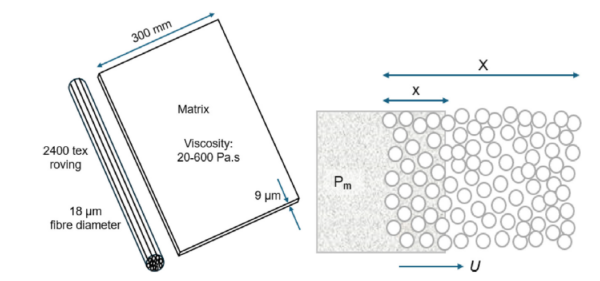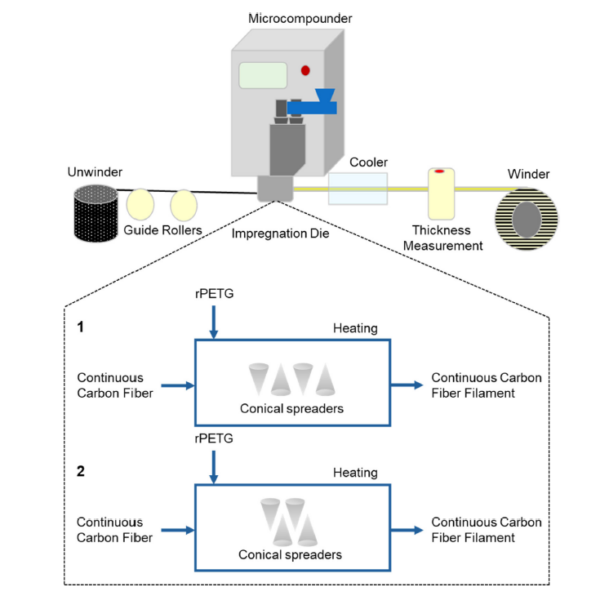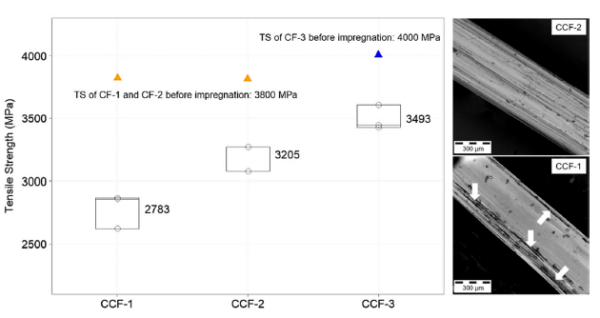Recycled PETG Powers Carbon Fiber Filaments for 3D Printing

In a recent study published in Polymer Composites, researchers led by Sütcüler et al. unveiled a lab-scale process to manufacture continuous carbon fiber (CCF) filaments using recycled PETG (rPETG).
Redefining Composite Filament Manufacturing
Traditional methods of producing carbon fiber-reinforced filaments for 3D printing often suffer from poor fiber alignment and inefficient impregnation. In response, the researchers designed a direct melt impregnation process that simplifies filament production and improves structural quality.
You can also read: Closing the Carbon Fiber Loop.

Schematic demonstration of the impregnation area (left), and impregnation of porous fiber bed (right). Courtesy of Lab-scale manufacturing of thermoplastic matrixcontinuous carbon fiber filaments for additive manufacturing: Melt impregnation, properties of the filaments and its printed composites.
The key innovation lies in eliminating the rounding step, which is commonly used to shape filaments but often introduces fiber misalignment and S-shaped distortion. By removing this step and using a custom conical pin system, the researchers achieved uniform fiber spread and enhanced impregnation with the polymer matrix.
Using Recycled PETG as a Matrix
This study focuses on recycled PETG, a thermoplastic offering excellent mechanical strength and processability for composite manufacturing applications. The researchers showed that rPETG flows efficiently at 260°C, which makes it well-suited for direct melt impregnation of carbon fibers. Moreover, using rPETG reduces the dependency on virgin plastics and aligns with sustainable design practices in modern material development. Additionally, this recycling approach diverts plastic waste from landfills and channels it into durable, high-performance composite materials. As a result, integrating recycled polymers into structural components creates circular opportunities in aerospace, automotive, and electronic product design.

Continuous fiber filament production system with horizontal (1) and vertical (2) impregnation pins design.Courtesy of Lab-scale manufacturing of thermoplastic matrixcontinuous carbon fiber filaments for additive manufacturing: Melt impregnation, properties of the filaments and its printed composites.
Continuous fiber filament production system with horizontal (1) and vertical (2) impregnation pins design.Courtesy of Lab-scale manufacturing of thermoplastic matrixcontinuous carbon fiber filaments for additive manufacturing: Melt impregnation, properties of the filaments and its printed composites.
Fiber Type Matters: Sizing and Performance
To evaluate performance, the team tested three types of carbon fibers with different sizing chemistries and mechanical properties. Results showed that the type of fiber sizing significantly influences tensile strength, fuzz formation, and overall quality of the filament. Notably, CF-2, a rigid carbon fiber with suitable sizing, achieved a tensile strength translation of approximately 84%, outperforming CF-1, a more flexible fiber. The right fiber and sizing combination ensured strong interfacial bonding, minimal fiber breakage, and excellent mechanical performance.

Tensile strength of CCFs produced with different carbon fibers. Courtesy of Lab-scale manufacturing of thermoplastic matrixcontinuous carbon fiber filaments for additive manufacturing: Melt impregnation, properties of the filaments and its printed composites.
Ready for 3D Printing
The final filaments were successfully processed in fused filament fabrication (FFF) 3D printers to create test samples. Mechanical testing, including interlaminar shear strength (ILSS) and dynamic mechanical analysis (DMA), revealed that filaments produced with CF-2 had 24.3% higher ILSS compared to CF-3.
Moreover, DMA results showed improved damping and energy absorption, essential for applications requiring vibration resistance and fatigue durability. SEM imaging confirmed better interfacial adhesion and reduced fiber damage in well-impregnated filaments.
Sustainable Impact and Industry Potential
This study carries significant implications for both composite manufacturing and plastic waste management. By enabling the use of recycled thermoplastics in high-performance, continuous fiber composites, this approach merges sustainability with structural integrity. Industries such as aerospace, defense, and automotive—which rely heavily on strong, lightweight materials—could adopt this technology to lower carbon footprints without compromising quality. The direct melt impregnation technique is scalable, cost-effective, and compatible with existing additive manufacturing platforms. In addition, it represents a viable pathway for converting industrial plastic waste into structural components, supporting circular economy goals and reducing landfill dependency.
Composites Manufacturing Landscape
Sütcüler and colleagues developed a practical method to produce composite filaments that combine strong mechanical performance with recyclability. Their research emphasizes the need for careful material selection, optimized processing, and sustainable design in future additive manufacturing practices. Moreover, as industries transition toward cleaner technologies, such innovative methods become essential to advancing circular, closed-loop production systems. Consequently, this approach will influence how we design, manufacture, and reuse high-performance materials in an increasingly sustainability-focused world.
